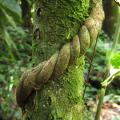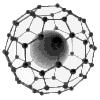
DMT-Nexus member
Posts: 146 Joined: 08-Apr-2017 Last visit: 22-Jan-2025
|
In the Tao or Rue extraction, there is a point where after the manske, the crystals are referred to as 'harmalas hcl' I told a friend this with more chemistry knowledge than me, and he told me that it isnt hcl because i didnt use any hydrochloric acid. now i am confuse. halp! wake 'n breakthrough bebiii
|
|
|
|
|

DMT-Nexus member
Posts: 1111 Joined: 18-Feb-2017 Last visit: 12-Jul-2024
|
But you used NaCl. The Cl anions come from that, and the H cations come from the acidity.
That's what Manske precipitation is about.
|
|
|

DMT-Nexus member
Posts: 557 Joined: 12-Jul-2012 Last visit: 01-Jan-2021
|
As with most alkaloids, the harmalas are in the plant tissue mostly or exclusively as some sort of salts. Boiling them extracts them and vinegar helps improve extraction efficacy.
You now have an impure solution of salts.
Adding base freebases them and you obtain the alkaloid base precipitate.
Dissolving this in vinegar converts them to the alkaloid acetate.
When salt (sodium chloride) is added, due to harmine/harmaline hydrochlorides low solubility in water combined with the salting-out effect of excess salt, the harmala acetates are converted to harmala hydrochlorides (and some sodium acetate is formed).
The hydrochlorides then crystallize out as needles or crystalline fluff, depending on conditions.
Once isolated and removed from the excess salt the hydrochlorides have a somewhat improved solubility in water and can be dissolved in warm water, giving a memorable flavor.
|
|
|

DMT-Nexus member
Posts: 1111 Joined: 18-Feb-2017 Last visit: 12-Jul-2024
|
Auxin wrote:Boiling them extracts them and vinegar helps improve extraction efficacy. I have wondered *why* vinegar helps improve extraction efficacy. Is it because it converts some of the naturally occurring alkaloid salts - which may not be very soluble in water - into the respective acetates, which are more soluble and therefore come out of the seeds more easily, or do the salts stay in their naturally occurring form during the boiling, but some other action of the acetic acid drives them out of the seeds?
|
|
|

DMT-Nexus member
Posts: 1104 Joined: 11-Feb-2017 Last visit: 18-Jan-2021
|
I also wonder about the vinegar and extraction.
Some teks call for a "dash of vinegar" - but a teaspoon of 7% acetic acid is hardly enough to convert all alkaloids to acetates if considerable amount of seeds is used (say 50-100 grams).
I guess acidic water is a better solvent for alkaloids than plain water... maybe.
Or maube it is added just to ensure acidity (e.g. neutralize base salts?) and thus make the extraction more efficient.
|
|
|

DMT-Nexus member
Posts: 337 Joined: 01-Dec-2017 Last visit: 09-Apr-2024 Location: Virtually on earth, Really everywhere
|
I love to think, using 2 acid (let's say acetic & citric) are a good thing, in this case, the acidic solution should contain mixed citrate & acetates ?
What do you think of using these 2 acid in conjunction ?
|
|
|

DMT-Nexus member
Posts: 557 Joined: 12-Jul-2012 Last visit: 01-Jan-2021
|
I've wondered about this too.
At the very least water should not be so basic as to freebase any of the alkaloids and some alkaloids with low pKa's may actually be in there in a mix of freebase and salt form.
In some situations vinegar helps by freeing alkaloid from scantly soluble alkaloid tannates and there may be other such things even in plant material free of tannic acid, like Peganum seed. Examples could be other polyphenols or acidic proteins.
There could also be an immobile acidic phase. Many plant polymers contain acid functionalities that could trap alkaloid like an ion exchange resin.
What we do know is that Manske himself used a large amount of vinegar in his published work.
Manske was no amateur, he published a couple dozen well received organic chemistry books, so I like to assume he wouldnt have included a detail like that without testing to see if it was indeed helpful.
|